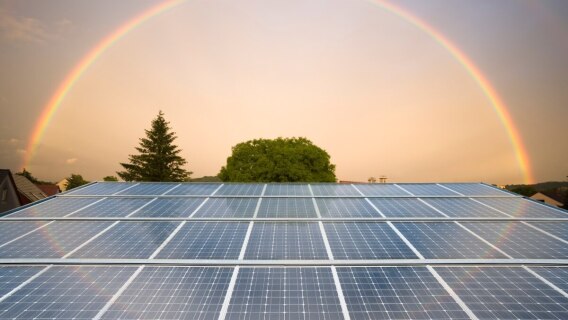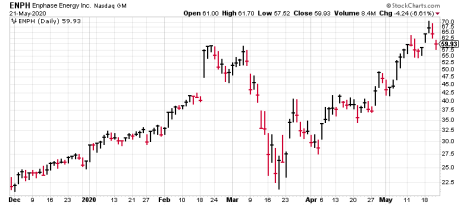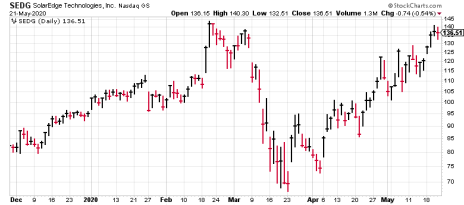Coal is dead; renewable energy is the future. And the best renewable energy stocks are worth your consideration. I’ll get to those in a bit.
Just look at the facts. A decade ago, coal provided nearly half of the electricity in the U.S. This year, coal is expected to provide just 19% of our electricity, as economic forces have compelled the closure of more and more coal plants. By 2025, analysts expect coal to account for just 10% of our electricity, and soon after that, none.
One factor in this unexpectedly rapid downtrend has been natural gas, which has enjoyed a supply boom as fracking increased our access to oil and gas. But a bigger factor has been the surprisingly quick adoption of renewable energy (mainly solar and wind), thanks to continuing lower costs.
[text_ad]
Year-to-date, in fact, renewable energy has produced more electricity than coal in the country on 90 separate days, a huge improvement over last year’s record of 38 days.
The coal industry, of course, has seasoned lobbyists, and they aren’t taking this beating quietly, but in the end, economics will win, and the result will be not only cheaper electricity but also cleaner air—and that makes everyone a winner.
So what are the best renewable energy stocks to invest in to take advantage of this trend?
Interestingly, it’s not the solar power panel manufacturers. They’re engaged in a cut-throat battle with Chinese companies so growth is unpredictable and margins are continually squeezed.
No, the best prospects today are a couple of firms that make key electronic components for the solar modules.
The 2 Best Renewable Energy Stocks
Best Renewable Energy Stock #1: Enphase (ENPH)
Located in sunny California, Enphase is the world’s leading supplier of microinverters, which convert direct current (DC) energy from solar modules into alternating current (AC). Its products are used all around the world (U.S., Europe, Australia), though it’s notably weak in the Chinese market. First-quarter results saw revenues of $206 million, up 105% from the year before and earnings of $0.38 per share, up 375% from the year before.
That‘s great growth, but that’s not all. A big reason why Enphase’s growth story still has plenty of upside is its Encharge battery system, which will allow homeowners to generate, store and control energy in a single system. All told, the firm believes its target markets will nearly quadruple in size by 2022; given the solar industry’s ups and downs, that’s not a sure thing, but there’s no doubt the potential is huge if things go right.
Today, the stock has a market capitalization of $7.3 billion, and the forward P/E ratio is 59, which is high, but lower than the growth rate!
As for the stock, it’s been public since 2012, and it’s had a lot of bull phases since then, interrupted by major pullbacks as the industry has been through boom and bust phases. But it’s been very strong since the March bottom, breaking out to new highs two weeks ago and extending the move last week.
Best Renewable Energy Stock #2: SolarEdge (SEDG)
Solar Edge, which went public in 2015, has a market cap of $6.7 billion and a forward P/E ratio of 45, so it’s definitely in the ballpark with Enphase. The company has invented a smart string inverter solution that’s a game-changer in harvesting power and managing it in a solar photovoltaic (PV) system for residential and commercial use. The company also makes power optimizers, which are electronics that attach to the back of solar panels.
In a SolarEdge DC system each PV module is connected to the intelligent power optimizer electronic chip that maximizes energy from that module individually. This means if one module is messed up, dirty or covered with snow, the others run unaffected. Think of it like a system that lets any given bulb in a Christmas light strand break, without affecting how any of the other lights perform. The company’s string inverter system is more expensive than more simple string-array systems, but more cost effective than micro inverter systems, which require an inverter for every PV module.
Big picture, SolarEdge should grow as the rooftop and distributed solar market grows. Industry analysts see rooftop and distributed solar as the fastest-growing area of the market due to declining technology costs, increasing efficiency, wider use cases (i.e. electric vehicle charging) and ease of use for first-time buyers, remote locations and emerging economies. Just to point to two examples, California has mandated that all new residential homes include rooftop solar systems as of the beginning of 2020, and Texas is ramping up solar use because it is now the lowest cost source of electricity in the state.
Revenue was up 59% to $431 million in the first quarter, while EPS was $0.95 per share, up 48% from the year before. As for the stock, it’s behaved a lot like ENPH, though as I write it has not quite broken out above its February high.
Note: You can get more information and advice on both these stocks, in Cabot Top Ten Trader and Cabot Early Opportunities.
[author_ad]



